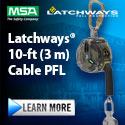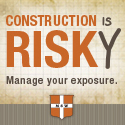
| www.agc.org • July 2016 |
Contact Us Archives
Subscribe Printer-Friendly AdvertiseSafety and HealthFacebook |
The Dangers of Highway Work Zones BY STEVEN H. MILLER
Every day, people in the road construction industry put their lives on the line ... just by showing up for work. Despite increasing safety consciousness and training, despite ongoing public awareness campaigns, high speed vehicle crashes into work zones continue to take the lives of workers and drivers at an alarming rate.
There’s a small bit of good news: the 2016 AGC of America Work Zone Safety Survey suggests that the number of crashes has fallen — slightly — since the last survey. In 2014, 45 percent of contractors responding to the survey reported having one or more crashes into their work zones. In 2016, it’s down to 39 percent.
For the workers out on the highway – who just want to get home every night alive and in one piece – it’s still too high. Ninety-six respondents – 30 percent of those who’d experienced crashes – had five or more in a year. Fifty-five contractors
report injured workers from those crashes, and 20 experienced worker fatalities.
Along with the human toll, there was an economic cost. Ninety-seven respondents said they had lost two or more days of work because of intrusions. The survey and conversations with those actively involved reveal that there’s general agreement about the problem, by contractors and owners alike. But putting solutions into practice successfully has been difficult.
PROBLEMS AND SOLUTIONS
First and foremost, virtually everyone believes that drivers need to slow down and pay attention in work zones. Getting the driving public to recognize this need has remained elusive. People continue to blast through work zones at full speed.
Use of positive barriers – according to 72 percent of contractors responding – would reduce injuries and fatalities. Only 51 percent report that their state or other public owners regularly include positive barriers in the bid, and 47 percent suggest that cost is the chief reason barriers are not used more often.
When asked if tougher laws are needed, 59 percent said yes. A whopping 82 percent believe that better enforcement of existing law is needed, and 77 percent say that more police presence at the construction site would reduce injuries and fatalities.
Safety training is another big issue. A large majority – 61 percent – feel that better or more frequent worker safety training would help.
The survey also made clear that contractors are not as engaged as they could be on this issue. A full 69 percent admit that they don’t know if their state includes work zone safety as part of new driver training.
AGC is fully engaged, however. Brian Deery, AGC of America’s senior director, highway & transportation division, reports that AGC is working with state DOTs and FHWA both to improve the safety of work zones and to increase awareness of the problem by the driving public.
"There’s a work zone awareness week, for which we do a national event to try and get more media attention," explains Deery. "In a number of states, they did things like turning the statehouse orange, and had various high profile events to try and get coverage."
But in a world of increasing traffic congestion, many drivers apparently feel that slowing down for a work zone is adding insult to injury. "When they get behind the wheel, they get very impatient," suggests Deery. "At the national safety event, the Ohio DOT director made a great point. The longest work zone in Ohio is seven miles. The difference between driving at 65 and driving at 45 is less than one minute."
From Deery’s point of view, the existing laws in most states are sufficient. "It’s enforcement that’s the issue. You see these signs doubling or tripling fines, but they really don’t enforce it. I think it would make a huge difference.
In states that don’t have significant fine increases, that could be done. But I really do think it comes down to enforcement. It’s an issue of cost, among other things. To give police their due, it’s often difficult to do enforcement in a work zone because there’s really no place to pull people over."
Dean Word, partner/manager, Dean Word Company, Limited, an AGC of Texas Highway, Heavy, Utilities & Industrial Branch member, in Braunfels, Texas, reports that Texas has adopted a force account item for uniformed law enforcement, paid by contractors and reimbursed by the state. They are often off-duty uniformed officers who sometimes have to use their personal vehicles with lights and sirens strapped on. "Their usage is by mutual agreement between the department and the contractor. We see it mostly for night-time work, if we have a single or multiple lane closure."
Two people who know the issue from the point of view of the insurance industry are Mark J. Troxell, ARM, vice president, safety services, and Jeffrey A. Spatz, CHST, CET, assistant vice president, The Graham Company, a member of multiple AGC chapters. They corroborate the effectiveness of visible law enforcement and the need for more of it.
"In my experience," says Spatz, "it is the norm, not the exception, for people to drive at excessive speed through work zones. The laws are there. I don’t think the enforcement of existing laws is consistent enough. I don’t think there’s enough resources to assign law enforcement in sufficient numbers."
Troxell notes that a live officer, not just a police car, is necessary. "When we have a police officer or state trooper, vehicles do slow down. When we’ve had the decoy out there, after the first trucks come through, they get on the radio and say, ‘Hey, it’s a decoy,’ and they begin to speed up."
Spatz has also seen a slowing effect from a speed sign with a license-plate camera. "As soon as people see that camera, they slow down."
WHAT CONTRACTORS CAN DO
Having been involved in many safety evaluations, they’ve seen positive steps a contractor can take, too. "One of the things that helps is when traffic patterns through the work zone are well established and well organized," suggests Spatz, "with traffic devices set up in the right places, and clear signage directing people where they need to go. All those things lend an air of credibility and respectability to a work zone. A work zone that’s sloppily set up, with devices haphazardly placed, I think it doesn’t garner any respect or credibility, and people tend to take it less seriously."
He also reports that exits, on-ramps, and places where construction vehicles leave the work zone and enter traffic, all pose special safety hazards. "Where we have the dump trucks coming into traffic, they need longer lanes and more of a transition for the truck to gain speed."
Troxell points out the value of good traffic control inspection. "Many states now require the contractor to have a traffic
control inspec- tor. We always recommend to our clients that you document your traffic control. We like to have them put their traffic inspections in electronically, and we put that right into the job file. That’s the first thing a lot of attorneys ask for: Was it inspected? Who inspected it?"
They cite positive barriers as very helpful, too. Troxell notes that Pennsylvania (their home state) uses a larger, heavier piece than the standard 32" Jersey barrier. "I’m a big fan of barrier, properly pinned so it doesn’t move too easily."
UP AGAINST THE BARRIER
Many contractors are frustrated by the issue of positive barriers. If barriers are not included as a bid item in the job, they hesitate to include the extra expense for safety because they’re afraid their bid won’t be competitive."
Tom Brown, president of Sierra Pacific West, a San Diego Chapter member, tells a tragic story about the consequences of this dilemma. "We had a project in San Diego, about a mile long," recalls Brown. "We put up all the signs, but the project didn’t call for positive barriers. We put in signs and message boards, everything. Some woman drove through that construction zone. She was drunk, and ended up killing a man on a bicycle. The man’s family sued us for not putting up positive barriers."
Brown insists that positive barriers should be in the bid. "I know this sounds hard core, but... if it means not doing the project, but I can go home at night knowing that I’m not putting lives in danger, I would do it. I would turn down projects that I feel are too dangerous."
|
||||
 2300 Wilson Boulevard, Suite 300 · Arlington, VA 22201 · 703-548-3118 (phone) · 703-548-3119 (fax) · www.agc.org
2300 Wilson Boulevard, Suite 300 · Arlington, VA 22201 · 703-548-3118 (phone) · 703-548-3119 (fax) · www.agc.org
About AGC | Advocacy | Industry Topics | Programs and Events | Career Development | News & Media
© Copyright 2025 The Associated General Contractors of America. All rights reserved.

